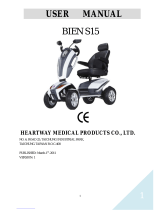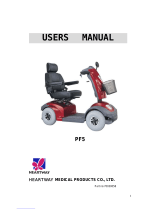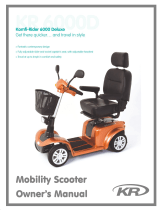Page is loading ...

2
CONTENTS
1. Technical Specification……………...........................................…………….3
2. Safety Instruction…………………………………………….…………………..4~6
3. Environment Condition…………………………………………….……………… ....7
4. Warranty……………………………………………………………..… … … … … ..8
5. Asse m bl y Inst ruc tion ………………………………………….……………..9
6. Adjustment For Seating Comfort………………….…………………………….……..11
7. Control Panel Layout……………………………….…………………………….…..12
8. Functions…..………………………….……………………………………..…13
8-1. Function Description………………………………...............................13
8-2. Buttons & Indicators……………………………………………….……..14
9. Usage Conditions…………..…….…………………………………………………14
10. Characteristics …………..………………………………………………………15
11. Operation of Control Panel………………………………………………………………15
11-1. Temperature Meter………………………………...............................15
11-2. Clock………………………………………………….……………….……..16
11-3. Odometer……………………………………………..…………………..17
11-4. Speedometer…………………..… … … .…..…………………………….19
11-5. High/Low Speed & Turn Indicator…………………………………….21
11-6. Power Indication…………………………………………………………...22
11-7. Headlight & Position Light…………………..…… ….………………….24
11-8. Brake and Reversing Light………………….………………………………….25
11-9. Direction Indicators ………………………………………………………...26
11-10. Malfunction Messages……………………..……………………………….27
11-11. Power-On-Self-Test… ………… ………..……………………………… ...28
12. System Configuration………………………………………………………………28
13. Circuit Diagram & BOM List....……………………………………………………29

4
SAFETY INSTRUCTION
OPERATION OF SCOOTER
1. To prevent injury to yourself or others, always ensure that the power is switched off when
getting on or off of the scooter.
2. Always check that the drive wheels are engaged (drive mode) before driving.
(Fig.1)
3. Do not switch off the power when the scooter is still moving forward. This will bring the chair
to an extremely abrupt stop.
(Fig.2) (Fig.3)
Engage
Free Wheel
Power Off
Power On

5
4. Emergency Brake (Optional)
General
1. Always use a seat belt, and keep your feet on the scooter all the time.
2. Do not over load the scooter with it’s maximum weight capacity of 135kg (300 lbs)
3. Do not attempt to lift or move a power scooter by any of its removable parts. Personal injury
and damage to the power chair may result.
4. Never try to use your scooter beyond its limitations as described in this manual.
5. Do not operate your vehicle if it is not functioning properly.
6. Do not connect any electrical or mechanical device to the scooter. Failure to obey this
instruction may result in injury and will void the warranty.
7. Never use electronic radio transmitters such as CB, walkie-talkies, portable computers or
cellular phones while using the vehicle without first turning the scooter off.
Use While Under The Influence Of Medication Or Alcohol
1. Check with your physician if you are taking any medication that may affect your ability to
operate your power scooter safely.
2. Do not operate your scooter while you are under the influence of alcohol, as this may impair
your ability to operate your power scooter in a safe manner.
Electromagnetic interference (EMI) from Radio Wave Sources
The rapid development of electronics, especially in the area of communications, has saturated our
environment with electromagnetic (EM) radio waves that are emitted by television, radio and
communication signals. These EM wave are invisible and their strength increases as one approach
the source. All electrical conductors act as antennas to the EM signals and, to varying degrees, all
power wheelchairs and scooters are susceptible to electromagnetic interference (EMI). The

6
interference could result in abnormal, unintentional movement and/or erratic control of the vehicle.
The United States Food and drug Administration (FDA) suggests that the following statement be
incorporated to the user’s manual for all power scooter like the S9. Power wheelchairs and
motorized scooters (in this section, both will be referred to as powered wheelchairs) may as
susceptible to electromagnetic interference (EMI), which is interfering electromagnetic energy
emitted from sources such as radio stations, TV stations, amateur radio (HAN) transmitter, two-way
radios and cellular phones. The interference (from radio wave sources) can cause the powered
wheelchair to release its brakes, move by itself or move in unintended directions. It can also
permanently damage the powered scooter’s control system. The intensity of the EM energy can be
measured in volts per meter (V/m).Each powered scooter can resist EMI up to a certain intensity.
This is called “immunity level”. The higher the immunity level the greater the protection. At this
time, current technology is capable of providing at least 20 V/m of immunity level, which would
provide useful protection against common sources of radiated EMI.
Following the warnings listed below should reduce the chance of unintended brake release or
powered scooter movement that could result in serious injury:
1. Do not turn on hand-held personal communication devices such as citizens band (CB) radios
and cellular phones while the powered scooter is turned on.
2. Be aware of nearby transmitters such as radio or TV stations and try to avoid coming close to
them.
3. If unintended movement or brake release occurs, turn the powered scooter off as soon as it is
safe.
4. Be aware that adding accessories or components, or modifying the powered scooter, may make
it more susceptible to interference from radio wave sources
(Note: It is difficult to evaluate the effect on the overall immunity of the powered scooter).
5. Report all incidents of unintended movement or brake release to the powered scooter
manufacturer, and note whether there is a radio wave source nearby.
TURN OFF YOUR POWERED SCOOTER AS SOON AS POSSIBLE WHEN EXPERIENCING
THE FOLLOWING:
‧ Unintentional scooter movements
‧ Unintended or uncontrollable direction.
‧ Unexpected brake release
The FDA has written to the manufacturers of power scooters asking them to test new products to be
sure they provide a reasonable degree of immunity against EMI. The FDA requires that a powered
wheelchair should have an immunity level at least 20 V/m, which provides a reasonable degree of
protection against more common sources of EMI. The higher the immunity level, the greater the
protection. Your powered scooter has an immunity level of 20 V/m which should protect against
common sources of EMI.

7
ENVIRONMENTAL CONDITIONS
Environmental conditions may affect the safety and performance of your power scooter. Water and
extreme temperatures are the main elements that can cause damage and affect performance.
A) Rain, Sleet and Snow
If exposed to water, your power scooter is susceptible to damage to electronic or mechanical
components. Water can cause electronic malfunction or promote premature corrosion of
electrical components and frame.
B) Temperature
Some of the parts of the power scooter are susceptible to change in temperature. The controller
can only operate in temperature that ranges between 18℉(-8℃) and 122℉ (50℃).
At extreme low temperatures, the batteries may freeze, and your power scooter may not be able to
operate. In extreme high temperatures, it may operate at slower speeds due to a safety feature of the
controller that prevents damage to the motors and other electrical components.

8
WARRANTY
Quality/ Warranty Declaration
Products are to be fit for purpose and of excellent quality and performance. For valid warranty
claims Heartway will, at their discretion, replace/ repair/ refund items mutually agreed to be
defective.
Heartway’s warranty as following:
(1) Frame: two year limited warranty
(2) Electronic Components and Charger: one year limited warranty.
(3) Controllers: one and half year limited warranty
(4) Batteries: not warranted.
(5) Consumables (wheel tires, arm pads, and seat cushions): not warranted.
Any damage or defect of any nature occurring from the misuse of the product is not to be covered.
The warranty is to start from the date of arrival of our products.

10
3. Installing the Batteries
Remove three screws as shown on Fig.7 and take off the cover. Connect both battery
cables probably (﹢/ ﹣pole ,Red is positive, black is negative)
(Fig.7) (Fig.8)
ADJUSTMENTS FOR SEATING COMFORT
A. Armrest Position Adjustment
(Fig.9)
Connected
Turn the round plate and adjust to your position.
Anticlockwise will move the armrest upward and
clockwise will be downward

11
B. Seat Rotation and Position Adjustment
B-1: Seat Rotation Adjustment
→ Press the seat swivel lever downward.
→ Rotate your seat by clockwise or counter-clockwise direction.
(Fig.10) (Fig.11)
B-2: Seat Position Adjustment
→ Push the seat adjust lever upwards.
→ slide your seat backward or forward to your desired position
→ let the lever lock into your preferred position.(See Fig 12)
Note: The distance of adjustment from backward to forward is 150mm.
(Fig 12)

12
OPERATION AND CONTROL PANEL
1. Control Panel Layout
LCD(Liquid Crystal Display)Power Scooter Control Panel, TN Type
Function & Adjustment Buttons
LED
Indications
LCD Screen
LED
Indications
Right Indicator
Headlight
Parking Indicator
Left Indicator
Right Indicator control
Parking lamp control
MODE button
Headlight control
Horn
Button
Left Indicator control
SET button
Position Light control
High / Low speed control
Warning Indicator
Position Light

13
2. Functions
2-1 Function Descriptions
FUNCTION
SPECIFICATION
1
Temperature
“C” / “F” modes
2
Clock
Hour / Minute display and setting
3
Odometer
Trip Meter
ODO (99999 max), TRIP (999.9 max)
Sum of distance and time
4
Speedometer
7 Segment display (2 1/2 digits +1 decimal)
“km/h” and “mph” symbol
5
High /Low Speed
& Turn Status
Indicated as icon and
6
Power Indicator
Battery remaining capacity and charging indicator
(6 squares + Battery icon)
7
Headlight
Blue LED
Including “Power-Saving” mode
8
Position Light
Orange LED
Placed inside headlight, used while rainy or gloomy weather
9
Brake Light
Including “Brake-Mode” and “Parking Mode”
10
Left-Right Direction
Indicators
Green LED
Flash mode
Auto switch-off after 30 seconds
11
Parking Light
Red LED
Including “Parking Mode”
Right/Left indicators flash simultaneously
12
Malfunction Messages
Red LED
Malfunction code:
7 Segment display (1digit) + warning symbol
13
Power-On-Self-Test
All LED illuminated

14
2-2 Buttons & Indicators
ITEM
DESCRIPTION
LED Indicators
Left-Indicator (Green)
Right- Indicator (Green)
Position Light (Amber)
Headlight (Blue)
Warning Indicator (Red)
Parking Indicator (Red)
LCD Backlight
Illumination: 700 mcd min (Orange color)
Connecter
CON1: 20PIN
3. Usage Conditions
ITEM
SPECIFICATION
Voltage
DC 24 V
Operation Voltage
DC 16 ~32 V
Storage Temperature
-40C ~ 90C
Operation Temperature
-25C ~ 55C
Meter Angle
at Handle Cover
30 of elevation while scooter assembly
(LCD orientate to 6 o’clock)
Function & Adjustment Buttons:

15
4. Characteristics Test
General Characteristic Performance Test (20 5℃)
Hardware Circuit:
ITEM
SPECIFICATION
RESULT (n = )
Lowest Operation Voltage
16V max
V
Consuming Current
(VB = 24.0V)
Dynamic: 200 mA max
(backlight and all of LED illuminated)
Static: 5 mA max
(Key Off status)
MA
mA
5. Operation of Control Panel
5-1. Temperature Meter
ITEM
DESCRIPTIONS
Operation Feature
Temperature sensor (NTC) detects and transfers the signal to a temperature value.
Tolerance
2C
Working Mode
Press to switch to TEMP-Mode:
* Display Range : -20C ~50C / -4F ~122F

16
ITEM
DESCRIPTIONS
Setting Mode
(Unit Switch)
Press + for more than 2 seconds to enter
Setting-Mode, and the backlight illuminates in the meantime.
When “C” or “F” flashing, press to switch C / F.
Exit
Setting Mode
Under Setting-Mode, when
1) idle for more than 20 seconds,
2) press + for more than 2 seconds,
the system will save the last setting value automatically and back to
Working-Mode.
5-2. Clock
ITEM
DESCRIPTIONS
Tolerance
±2 sec. (per day)
Initial
Setting Value
『Hour:Min』mode :『AM 12:00』
Working Mode
Press to switch to CLOCK-Mode:
AM
PM
Display Range : AM12:00 ~ PM11:59
During 1 to 9 o’clock, “0” of tens on Hour digits won’t show on LCD.

17
ITEM
DESCRIPTIONS
Setting Mode
(Time Switch)
Press + for longer than 2 seconds to enter Setting-Mode,
the backlight illuminates in the meantime.
1) When “Hour” digit is flashing, press to increase the number, and
then press into “Min” setting mode.
2) When “Min” digit is flashing, press to increase the number, then
press back to “Hour” setting mode.
If press for longer than 2 seconds, the number will increase
continually till the button released.
The setting value runs cyclically ( only 2 sec. from 0 to 9)
Exit Setting Mode
Under Setting-Mode, when
1) idle for longer than 20 seconds
2) press + for longer than 2 seconds,
the system will save the last setting value automatically and back to
Working-Mode.
5-3. Odometer
ITEM
DESCRIPTIONS
Operation Features
OptoCoupler sensor detects the signal and then converts into a distance value.
Units Switch
When speedometer was set as
「km/h」, the odometer displays as kilometer.
「mph」, the odometer displays as mile.
「/h」, means the odometer is displaying as travel hours.

18
ITEM
DESCRIPTIONS
ODO Mode
Press switching to『ODO』mode
km/h
mph
Display Range:00000~99999
When the total distance ran to 99999km or 62149mile (99999÷1.609mile), the
digits will be reset to zero “00000”.
TRIP Mode
Press switching to『TRIP』mode
Display Range:0.0~999.9
When the distance goes to 999.9, the counter will stop, please press
for 3 seconds to reset to zero “0.0”.

19
5-4. Speedometer
ITEM
DESCRIPTIONS
Operation Features
OptoCoupler sensor detects the signal and then converts into a speed value.
When drive shaft runs at 2100 rpm, speedometer will display “60km/h”.
Tolerance
+15~20%
Digits range
0.0 ~ 30.0 Display Rate:0.5
Setting Mode
(Units Switch)
Press + for longer than 2 seconds to enter
Setting-Mode, backlight illuminates in the meantime.
When 『km/h』 / 『mph』/ 『/h』are flashing, press to switch
the unit.

20
ITEM
DESCRIPTIONS
Working Mode
Press to enter 『SPEED』mode
km/h
mph
「km/h」means the speed is counted as kilometer.
「mph」means the speed is counted as mile.
When SPEED was set on “km/h” or “mph”, even the waiting screen is not
SPEED mode, LCD will switch to SPEED mode when WIP (accelerator) is
acting, and back to previous waiting screen automatically once WIP
(accelerator) stopped.
When SPEED was set on “/h”, speedometer will be disabled (fit to
non-speedometer model) and replaced by WIP (accelerator) operation screen.
Forward Backward
When SPEED was set on “/h”, LCD won’t switch automatically to SPEED
mode from another screen while WIP acted.
Exit Setting Mode
Under setting mode, when
1) idle for 20 seconds
2) press + for longer than 2 seconds,
the system will save the last setting value automatically and back to
Working-Mode.
/












